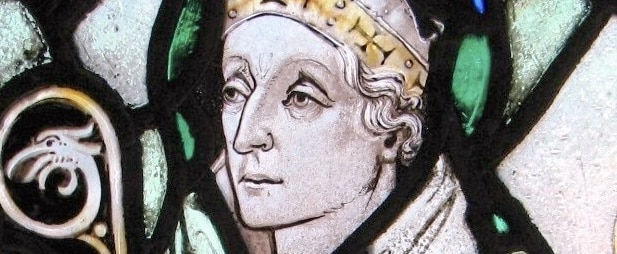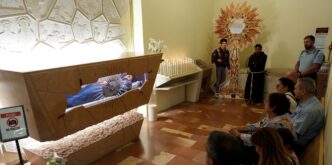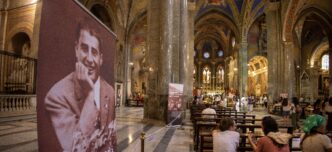St. Aidan of Lindisfarne
Feast day: Aug. 31
“Aidan cultivated peace and love, purity and humility: He was above anger and greed, and despised pride and conceit; he set himself to keep and teach the laws of God, and was diligent in study and prayer. He used his priestly authority to keep the proud and the powerful in check; he tenderly comforted the sick; he relieved and protected the poor.”
These are the words of historian St. Bede the Venerable, describing St. Aidan of Lindisfarne, known as the Apostle of Northumbria, who lived from about 590 until 651. Although Bede was born about 20 years after St. Aidan died, he, like many others, was inspired by the reputation of this Irish monk and missionary who came to evangelize the people of northern England.
St. Aidan studied in the Irish tradition on the isle of Iona off the west coast of Scotland at the abbey founded by St. Columba. At the request of King Oswald — who had been in exile on Iona, where he was probably baptized — St. Aidan traveled to Northumbria in about 634 to lead a successful mission to convert the Northumbrians from Anglo-Saxon paganism to Christianity.
The base for his evangelization efforts was Lindisfarne, or Holy Island, a small island off the east coast of England. There he founded Lindisfarne Abbey, as well as a school for English boys, several of whom later became canonized saints. Their curriculum of reading, writing and Latin included Bible studies and copying the Bible, giving us the Lindisfarne Gospels many years later. St. Bede tells us that as donations to the monastery increased, St. Aidan used some of the money to buy children out of slavery.
At first not knowing English and always speaking with an Irish accent, St. Aidan liked to preach by simply walking from place to place in Northumbria and talking to those he met on the road. When the king offered St. Aidan a horse, he gave it to a beggar as he wanted to be on the same level as the common man. He was known as a man of peace and charity, who chose to walk without a weapon at a time when many travelled armed. St. Bede reports that it was the unselfishness of St. Aidan and his monks that made them liked by locals and convinced many of them to become Christians.
St. Aidan founded the church at Bamburgh, among other monasteries and churches in northern England. He also inspired the abbessess St. Hilda and St. Hieu to found their own monasteries. Moreover, Lindisfarne flourished as a major ecclesiastical center until the Danish invasions began in 793.
After 16 years as bishop of Lindisfarne, St. Aidan died at Bamburgh in 651, and it is said that a fiery vision of his soul going up to heaven convinced the teenage shepherd St. Cuthbert to become a priest. Shortly after this sight, St. Cuthbert asked for permission to join Melrose Abbey.
St. Aidan was buried on Lindisfarne, but his remains have been distributed to other religious sites. It is unknown who was the first person to bring Christianity to England; there is no obvious original apostle. However, St. Aidan is clearly a significant figure, a humble and mild man who gave his all as an evangelizer in northern England.
Reflection
Dear Jesus, may I look for opportunities to bring people back to you. Help me to shine your light in humility, kindness and gentleness.
Prayer
O God, who in blessed Aidan of Lindisfarne were pleased to provide for your Church the example of a good shepherd, mercifully grant that through his intercession we may merit an eternal place in your pastures. Through our Lord Jesus Christ, your Son, who lives and reigns with you in the unity of the Holy Spirit, God, for ever and ever.







